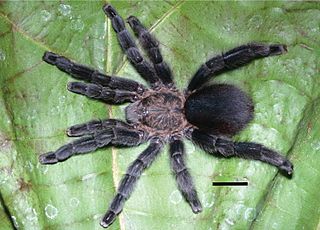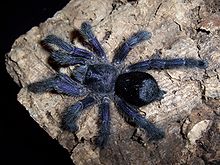
Avicularia is a genus of the family Theraphosidae containing various species of tarantulas. The genus is native to tropical Central and South America. Each species in the genus has very distinguishable pink foot pads.

The Antilles pinktoe tarantula, also known as the Martinique red tree spider or the Martinique pinktoe is popular as a spider pet because of its docile character and unique coloration.

Tarantulas comprise a group of large and often hairy spiders of the family Theraphosidae. Currently, 1,010 species have been identified. The term "tarantula" is usually used to describe members of the family Theraphosidae, although many other members of the same infraorder (Mygalomorphae) are commonly referred to as "tarantulas" or "false tarantulas". Some of the more common species have become popular in the exotic pet trade. Many New World species kept as pets have setae known as urticating hairs that can cause irritation to the skin, and in extreme cases, cause damage to the eyes.

The skeleton tarantula, Ephebopus murinus, is a species of spider belonging to the family Theraphosidae (tarantulas), sub-family Aviculariinae. A New World species, it is native to several South American countries. Its common name is derived from the skeleton-like markings on its legs.
The Stromatopelminae are a subfamily of tarantulas native to West Africa and part of Central Africa. The subfamily was first proposed by Günter Schmidt in 1993.

Typhochlaena curumim is a species of tarantula, that is native to Mata do Pau-Ferro, Areia, in the state of Paraiba, Brazil. It is a member of the subfamily Aviculariinae.
The Eumenophorinae are a subfamily of tarantula spiders. They are known from genera distributed across Africa, southwestern countries in Saudi Arabia, and Madagascar and the associated islands.

Pachistopelma bromelicola is a species of tarantula, contained within the Aviculariinae subfamily. It is endemic to Brazil.

Pachistopelma rufonigrum is a species of theraphosid, contained within the Aviculariinae subfamily. It is endemic to Brazil.
Antillena is a genus of spiders in the family Theraphosidae (tarantulas). As of March 2017, the genus contained a single species, Antillena rickwesti, found in the Dominican Republic.
Caribena is a genus of spiders in the family Theraphosidae (tarantulas), found in the Antilles. The two species accepted as of March 2017 were formerly placed in Avicularia. Apart from a different distribution – Avicularia species are found in mainland South and Central America – Caribena is distinguished by having longer and thinner type II urticating hairs in a conspicuous patch on the upper surface of the abdomen. Males also have a differently shaped palpal bulb.
Ybyrapora is a genus of spiders in the family Theraphosidae (tarantulas), found in Brazil. Its species were formerly placed in the genus Avicularia.

Avicularia juruensis is a species of spider in the family Theraphosidae, found in South America. Avicularia urticans was brought into synonymy in 2017. It has been given the English name Amazonian pink toe spider. Under the synonym Avicularia urticans, it is also known as the Peruvian pinktoe tarantula. It is a large mygalomorph spider, with a maximum body length over 30 mm (1.2 in) and the longest fully extended leg about 60 mm (2.4 in). Like other species in the genus Avicularia, specimens under this name are sold as pets, although their identity has not been confirmed by taxonomic studies.

Avicularia variegata is a species of spider in the family Theraphosidae found in Venezuela and Brazil. Previously described as Avicularia avicularia variegata, it is synonymous with Avicularia bicegoi.

Avicularia rufa is a species of spider in the family Theraphosidae. Specimens from the Brazilian states of Mato Grosso and Rondônia have regularly been misidentified as Avicularia juruensis. One difference is the vivid yellow rings on the legs of A. rufa compared to the paler rings of A. juruensis.

Avicularia lynnae is a species of spiders in the family Theraphosidae, found in Ecuador and Peru. It was first described in 2017. The specific name refers to Lynn West, wife of mygalomorph expert Rick C. West.

Avicularia caei is a species of spiders in the family Theraphosidae found in Brazil. It was first described in 2017. The specific name honours Carlos Eduardo Gurgel Paiola, known as "Caê".
Avicularia glauca is a species of spider in the family Theraphosidae, found in Panama. The species was first described by Eugène Simon in 1891. As of March 2017, only a single female preserved specimen is known. It appears to be closely related to Avicularia purpurea. Avicularia species are rare in southern Central America; further studies are in progress.
Rick C. West is a Canadian arachnologist with a main expertise toward tarantula spiders. West was born in Victoria, British Columbia. He has been interested in spiders since childhood, and collected his first tarantula, Aphonopelma eutylenum at the age of 13. He worked primarily as a Chief Constable for a local Animal Humane Society, but also have been involved with the collecting, breeding, rearing and photography of theraphosid spiders. West has traveled to over 27 countries to document and study them in their environment, has been a host, presenter and co-producer in several tarantula documentaries and has also described several new species.

Idiothele mira, also known as the blue-foot baboon or the trap-door tarantula, is a species of tarantula endemic to South Africa and is popularized by hobbyists for the striking blue coloration on the ventral side of the tarsi and metatarsi on each leg. Furthermore, the species is well known for belonging to one of two described genera of theraphosids that build a trapdoor, the other being Typhochlaena.













